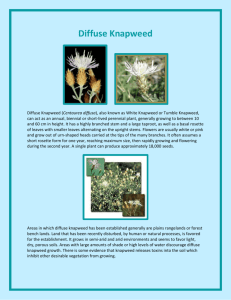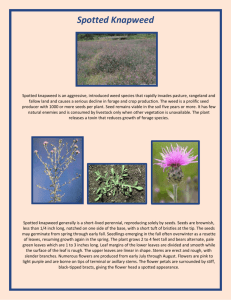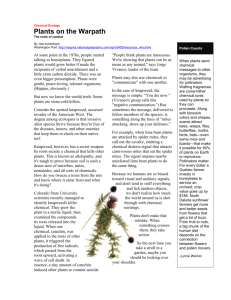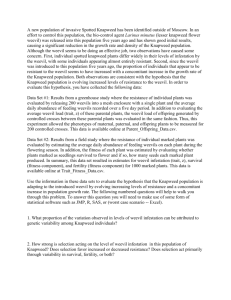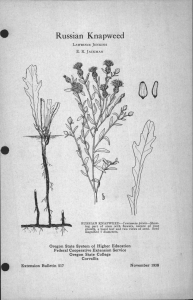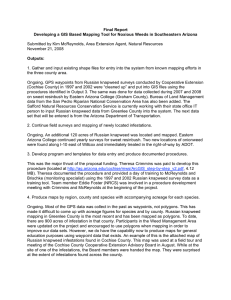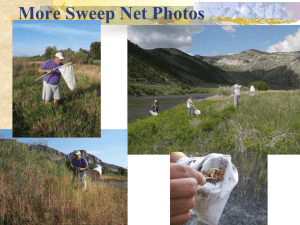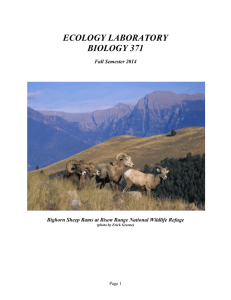United States Department of Agriculture NATURAL RESOURCES CONSERVATION SERVICE
advertisement
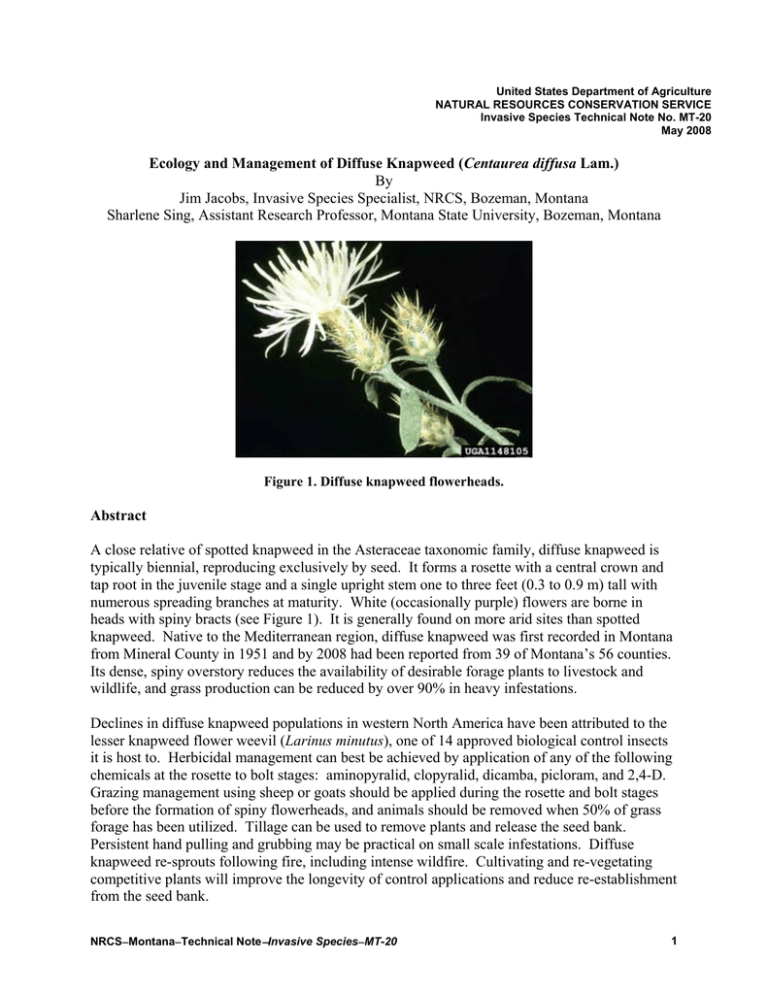
United States Department of Agriculture NATURAL RESOURCES CONSERVATION SERVICE Invasive Species Technical Note No. MT-20 May 2008 Ecology and Management of Diffuse Knapweed (Centaurea diffusa Lam.) By Jim Jacobs, Invasive Species Specialist, NRCS, Bozeman, Montana Sharlene Sing, Assistant Research Professor, Montana State University, Bozeman, Montana Figure 1. Diffuse knapweed flowerheads. Abstract A close relative of spotted knapweed in the Asteraceae taxonomic family, diffuse knapweed is typically biennial, reproducing exclusively by seed. It forms a rosette with a central crown and tap root in the juvenile stage and a single upright stem one to three feet (0.3 to 0.9 m) tall with numerous spreading branches at maturity. White (occasionally purple) flowers are borne in heads with spiny bracts (see Figure 1). It is generally found on more arid sites than spotted knapweed. Native to the Mediterranean region, diffuse knapweed was first recorded in Montana from Mineral County in 1951 and by 2008 had been reported from 39 of Montana’s 56 counties. Its dense, spiny overstory reduces the availability of desirable forage plants to livestock and wildlife, and grass production can be reduced by over 90% in heavy infestations. Declines in diffuse knapweed populations in western North America have been attributed to the lesser knapweed flower weevil (Larinus minutus), one of 14 approved biological control insects it is host to. Herbicidal management can best be achieved by application of any of the following chemicals at the rosette to bolt stages: aminopyralid, clopyralid, dicamba, picloram, and 2,4-D. Grazing management using sheep or goats should be applied during the rosette and bolt stages before the formation of spiny flowerheads, and animals should be removed when 50% of grass forage has been utilized. Tillage can be used to remove plants and release the seed bank. Persistent hand pulling and grubbing may be practical on small scale infestations. Diffuse knapweed re-sprouts following fire, including intense wildfire. Cultivating and re-vegetating competitive plants will improve the longevity of control applications and reduce re-establishment from the seed bank. NRCS−Montana−Technical Note−Invasive Species−MT-20 1 Plant Biology Identification Basal leaves are whorled from the central crown of the elongated taproot to form a low-lying rosette. Rosette leaves grow up to eight inches long (20 cm) and two inches (5 cm) wide, have short stalks, and are deeply divided into lobes on both sides of the midrib. Stem leaves are similarly divided but sessile, alternately arranged on the stem, and become progressively smaller and less divided higher up the stem. The uppermost leaves are small and bract-like. Stems grow from one to three feet tall (0.3 to 0.9 m), with numerous branches giving the plant a ball-shaped form that tumbles in the wind when broken off. The flowerheads are urn-shaped, about 0.2 inch (3 to 6 mm) wide and up to 0.63 inch (16 mm) long. The bracts surrounding the heads are yellowish-green with buff or brown margins fringed with spines, and ending with a long spreading, stiff spine. Heads are solitary or in clusters of two or three at the branch ends. Most flowers are white, but pink or purple flowers are not uncommon. The achenes (seeds) are 0.12 inch (3 mm) long, light-brown to black, with a pappus of bristle-like hairs that are scale-like to less than 1 mm long. Life History Normally a biennial, diffuse knapweed can complete its life cycle in a single year when germination occurs in the early spring. Otherwise, this species behaves as a short-lived perennial, depending on prevailing environmental conditions. Plants generally die after seed production, and re-growth from the root crown after seed production is rare. Seeds germinate in the fall or spring and seedling survival is dependent on seasonal precipitation. Because germination occurs throughout the growing season, seedling emergence is distributed over time. These factors combined with a continuous seed rain and sequential establishment ensures population occupancy of available safe sites with individuals of different age classes (seedlings, rosettes, and flowering adults). Diffuse knapweed populations effectively draw resources from different levels of the soil profile, reducing intra-specific, while increasing inter-specific competition. This near-complete utilization of soil resources effectively results in monocultures of diffuse knapweed in heavy infestations. Under intense intra-specific competition, plants die before flowering or live for several years as rosettes and die after seed production. Maximal root elongation occurs as seedlings develop into rosettes. Plants that overwinter as rosettes will bolt in early May. Flowering occurs from June to September, provided that adequate moisture is available and temperatures are mild. Pollination is usually via insects; however, plants are selfcompatible. Individual plants can produce over 700 seeds and population seed production has been recorded as high as 40,000 seeds/m2. Spread Diffuse knapweed flowerheads have effective mechanisms for short- and long-distance dispersal. After seed production, the majority of heads remain closed with seeds intact until fall. Once the heads are fully dry, involucres on the sides of the heads open and seeds drop for short distance dispersal. For long-distance dispersal, plants break off at ground level and tumble in the wind, dispensing seeds individually through small openings at the tip of the heads. Seeds also spread long distances when the tumble weeds attach to vehicles or equipment. Rivers and irrigation systems can also carry entire plants and their seeds long distances. Colonization and spread of diffuse knapweed is enhanced when the competitiveness of the plant community is compromised NRCS−Montana−Technical Note−Invasive Species−MT-20 2 by disturbance or limiting resource shortfalls. Prescribed grazing to maintain competitive grasses is important to reducing the spread of diffuse knapweed. Habitat Diffuse knapweed is native to the grasslands, shrub steppes, and fringe forest of eastern Mediterranean and western Asian locales with a climate characterized by arid summers. This species has demonstrated wide ecological amplitude in colonizing western North America. In North America, it is most invasive in shrub steppe with light, well-drained soils that support bitterbrush/bluebunch wheatgrass communities. It does not grow in poorly-draining soils or intense shade, but can dominate in open ponderosa pine and Douglas fir community types. Dry pastureland and meadows dominated by Kentucky bluegrass are susceptible to invasion. In Montana, the largest infestations are found on native grasslands and fringe forest areas near Big Timber, Ennis, and Helena. Impacts Significant environmental and economic impacts have been associated with diffuse knapweed infestations. A Washington State economic analysis estimated losses of nearly $1 million in pasture and rangeland grazing revenue and $2.9 million in lost hay revenue in 1988. A study on the Colorado Front Range found that species richness decreased as diffuse knapweed cover increased, and that total vegetation cover decreased and bare ground increased with increasing diffuse knapweed cover and density. These results support reports that diffuse knapweed infestations reduce biodiversity through their ability to form near monotypic stands. Also, apparent increases in soil erosion and reduced water infiltration and cycling attributed to increased bare ground and reduced bunchgrasses in diffuse knapweed infestations are supported by this study. Diffuse knapweed increases the cost of roadside maintenance, threatens natural area preserves, and reduces land values. Management Biological Control Larinus minutus. Reductions in diffuse knapweed populations in Montana, Oregon, and Washington have been observed following the release of the lesser knapweed flower weevil, Larinus minutus. In Colorado, diffuse knapweed cover declined from 8.3% to 1.9% over one year after the insects were released, and in one area, diffuse knapweed disappeared entirely. Diffuse knapweed cover increased from 14.5% to 17% in a nearby area where the insects were not present. Reductions of 95% or greater in diffuse knapweed stand density have been reported from L. minutus release sites in Washington state. NRCS−Montana−Technical Note−Invasive Species−MT-20 3 Figure 2. The exit hole of an adult Larinus minutus weevil from the pupal cell in a diffuse knapweed flowerhead (photo by Bob Richards, USDA-APHIS). Adult weevils emerge from overwintering sites approximately four weeks before the diffuse knapweed flower buds begin to form. Due to their sensitivity to high temperatures, adult weevils are primarily active (and most apparent) during the relatively cooler morning or evening hours, from May through mid-September. Feeding damage to diffuse knapweed foliage, shoots and immature flower buds in spring or early summer when newly-emerged adult weevils are aggregated and feeding in high densities can result in significant shoot stunting, flowerhead abnormalities, or even plant mortality. Over-wintered female weevils must feed on the host plant before ovariole maturity can occur; oviposition then begins on newly-opened flowers. Eggs are deposited among individual pappus hairs on plants typically free of significant adult feeding damage. Larvae complete three instar stages over a four week period; at this time they actively feed on florets, developing seeds and pappus hairs and are capable of consuming all seeds produced in a head. Mature larvae (one per flowerhead) construct pupal cells from seed debris and pappus hairs. The pupal cell is a domed, straw-colored structure filling the capitulum (bottom) of an otherwise empty seedhead. Pupal color changes from white to brown just before adult emergence. Empty pupal cells have a large hole in the center marking the adult weevil’s exit point (see Figure 2). The reproductively immature adults over-winter protected in the soil and litter near the base of plants. Adult weevils can be collected by aspirator (see Figure 3) when they congregate in large numbers around the root crown in spring, or they can be swept from the diffuse knapweed foliage before 50% bloom is attained. After 50% bloom the females are more likely to have laid their full compliment of eggs and will not effectively spread the insect population. In laboratory cultures of the weevil, the adult lifespan ranged from five to 14 weeks. Larinus minutus prefers hot, dry areas and does poorly at high elevations and in areas with prolonged rainfall. Livestock grazing while plants are bolting is detrimental to L. minutus population buildup because the females will disperse to find flowering plants. NRCS−Montana−Technical Note−Invasive Species−MT-20 4 Figure 3. A simple aspirator used to collect adult Larinus minutus in the spring from diffuse knapweed root crowns (photo by Sharlene Sing). Diffuse knapweed is currently host to 12 other insects and one nematode released in North America for the control of knapweed species (see Table 1). In addition, Sclerotinia sclerotiorum is a common native soil fungus that infects the crowns of diffuse knapweed, and Puccinia jaceae var. diffusea attacks the leaves. These fungi are not cleared as bio-control agents and pathogenetic control of diffuse knapweed using fungi, bacteria, or viruses has had limited consistent success in field applications. Table 1. Biological control insects for management of diffuse knapweed, the site of attack on the plant, insect life stage and time of collection, and the collection method for redistribution. Insect Agapeta zoegana Bangasternus fausti Chaetorellia acrolophi Cyphocleonus achates Larinus minutus Larinus obtusus Metzneria paucipunctella Pelochrista medullana Pterolonche inspersa Sphenoptera jugoslavica Type Site of attack Moth Root Weevil Flower head Fly Flower head Weevil Root Weevil Flower head Weevil Flower head Moth Flower head Moth Root Moth Root Beetle Root Collection Collection method Larvae/rosette Adults/bud Hand pick Sweep net Larvae-pupae/seed heads(fall-winter) Adults/flowering Whole plant bouquets Adults/flowering Aspirate or sweep net before 50% bloom Sweep net Adults/flowering Larvae-pupae/seed heads (fall-winter) Larvae/late winter or adults/flowering Larvae/late winter or adults/flowering Adults/flowering NRCS−Montana−Technical Note−Invasive Species−MT-20 Sweep net, hand pick Whole plant bouquets Hand pick or sweep net Hand pick or sweep net Sweep net 5 Table 1 (continued). Biological control insects for management of diffuse knapweed, the site of attack on the plant, insect life stage and time of collection, and the collection method for redistribution. Insect Type Site of attack Subanguina picridis Nematode Stem leaves Fly Flower Terellia virens head Fly Flower Urophora affinis head Fly Flower Urophora head quadrifasciata Collection Collection method Larvae Galls Larvae-pupae/seed heads (fall-winter) Larvae-pupae/seed heads (fall-winter) Larvae-pupae/seed heads (fall-winter) Whole plant bouquets Whole plant bouquets Whole plant bouquets The Urophora seed head flies were released over 25 years ago in Montana and are now well established throughout most knapweed-infested areas in the western United States. These species have been observed to reduce seed production by 50% or more. Competition inhibits overall bio-control efficacy when multiple seed-feeding agent species are present in the same release sites. Other flower-head feeding insects are not as well distributed, but may be as effective as the Urophora flies. The other flower-head weevil, Larinus obtusus, and the Metzneria seed-head moth are established in Montana and believed to be effective in reducing seed production. Larinus weevils prefer hot, dry sites while Metzneria does best on sites with winter snow cover. The Bangasternus seed-head weevil is not widely established in Montana. However, it is reported to consume up to 100% of the seeds per flowerhead where it has established. Poor establishment of the Chaetorellia and Terellia flies is believed to be the result of competition with other flower-head insect species. Of the root-feeding insects, the Agapeta root moth, Cyphocleonus root weevil, and Sphenoptera root borer are well established in parts of Montana. These species prefer hot, dry, open sites. The Pelochrista root moth first released in Montana in 1984 has been slow to establish for unknown reasons. The Pterolonche root moth was released and established in Oregon in 1986 but has not been recovered since 2000, presumably due to the locally dramatic control of diffuse knapweed by Larinus weevils. Establishment, Collection, and Redistribution of Bio-Control Insects The minimum number of insects needed to establish a sustainable population is 200 insects, but more is generally better. The knapweed infestation for insect release and establishment should be at least two acres in area and moderately dense to very dense (three or more knapweed plants per square yard). Bio-control releases should only be made on land that will not be treated with herbicides in the following three to five years, and where relatively slow evidence of control will be acceptable. Sites should be open and not forested. Insects collected for redistribution should be released on the new site as soon as possible after they are collected, and kept cool (but not frozen) during collection, transport and storage. Retain collected insects in large coolers equipped with “blue ice” wrapped in towels so that direct contact is not made with the insect containers. Collected insects should be kept in breathable containers that allow air flow and where condensation will not form. Non-waxed ice cream containers work well, paper bags will work if they are not crushed or saturated when chilled, and pillow cases are convenient for NRCS−Montana−Technical Note−Invasive Species−MT-20 6 collecting and transport. Do not use plastic bags. Including some fresh knapweed in the container reduces crowding and confinement stress, and gives the insects something to congregate and feed on. Release sites may be marked with a steel post to help relocate the site for monitoring. Make sure you take the time to complete a release record for each release site; the record should include: date of release, species and number of insects released, site GPS coordinates or township/ range/section, and descriptive directions to the release point. Whole plant bouquets can be tied directly to the post or to fence posts. Weevils, moths and flies should be released on the ground within three feet of the marking post. The best time to release insects is during the cool times of the day in the morning or evening. Dump insects out of containers – this avoids attracting the attention of predators and curious wildlife or livestock, and prevents accidental drowning in the event of a significant rainfall! The post can be used as a photo point to sequentially monitor any change in the weed population and plant community after release. It may take two to three years for an insect population to establish. High release numbers may reduce the time between establishment and significant impact. Herbicidal Control 1/ Herbicides are effective for short-term control of diffuse knapweed. Table 2 lists herbicides, rates, soil half-life, and eco-toxicity for chemicals commonly used to control diffuse knapweed. The length of control (i.e., the time the population regenerates from seeds in the soil) will depend on the soil residual activity of the herbicide, soil texture, precipitation, and the competitiveness of the plant community. Picloram applied at one pint product per acre (0.25 pounds active ingredient/acre) is the standard recommendation for herbicidal control of diffuse knapweed and can provide 90% population reduction for three or more years on loamy soils with a wellmaintained grassland community. However, picloram is a restricted-use herbicide and cannot be applied near surface water or where there is a high water table. It is water soluble, mobile, and will leach quickly from the rooting zone in sandy soils. Picloram also breaks down in sunlight which reduces its residual activity. Because of the residual activity, timing of picloram application is not as critical as with other herbicides with less residual activity (indicated by halflife in Table 2). Spring, early summer, and fall applications result in the greatest control. Application during the hot and dry part of the summer should be avoided because uptake into the plant is limited when plants are dormant and the active ingredient breaks down rapidly in the sun. An economical alternative to picloram is 2,4-D, a broadleaf-selective herbicide, which can be applied to environmentally-sensitive areas or where the use of picloram is prohibited. The timing of 2,4-D application is important to maximizing control because this herbicide has brief residual soil activity (see Table 2). To have the greatest reduction of diffuse knapweed populations, 2,4-D should be applied after most of the seeds have germinated and before plants flower, generally at the late bud stage but before flowers appear. This timing will target early summer rosettes, prevent the transition from rosette to flowering plant, and eliminate seed 1/ Any mention of products in this publication does not constitute a recommendation by the NRCS. It is a violation of Federal law to use herbicides in a manner inconsistent with their labeling. NRCS−Montana−Technical Note−Invasive Species−MT-20 7 production. Repeated annual applications of 2,4-D may be necessary to maintain control of stands effectively regenerating from the soil seed bank. However, re-application will depend on the degree of seedling suppression by competitive plants. Other herbicides available for control of diffuse knapweed in sensitive areas include products that contain dicamba, clopyralid, or triclopyr. These herbicides are more expensive than 2,4-D but clopyralid and triclopyr do not injure as many non-target forb species as 2,4-D, which makes them an attractive option where preserving the forb community is important to management objectives. These chemicals have residual activity greater than 2,4-D but less than that of picloram (see Table 2). Timing of application for these herbicides for optimum control of diffuse knapweed is similar to the timing recommended for 2,4-D. Aminopyralid is a recently developed chemical that is effective for controlling diffuse knapweed. Its chemistry is very similar to that of picloram, clopyralid, and triclopyr. The mobility of aminopyralid in the soil is very high, however because of low application rates and short soil half-life, most of the chemical remains within the upper 12 inches of the soil profile. Aminopyralid can be used to treat ditch banks and other channels that do not carry water used for irrigation or drinking. There are risks associated with herbicidal control of diffuse knapweed that should be balanced against the resulting benefits, and the risks of alternative management actions, including the no action alternative, when making weed management decisions. Potential risks include adverse effects on human and environmental health, and economic costs. The risks to human and environmental health can be minimized by strict adherence to application requirements defined on the herbicide label. The relative risks of chemicals can be compared by their eco-toxicity evaluations (see Table 2). Generally, the chemicals listed pose a low risk to human and environmental health. However, the degree of risk is dependent on dose and frequency of exposure. Frequency of exposure can be minimized by integrating non-herbicidal population regulation to reduce the number of herbicide re-applications. This will also reduce economic risk. Maintaining competitive grasses can reduce the number of herbicide applications needed to suppress diffuse knapweed, thereby reducing environmental risk. Table 2. Chemical and product name, recommended application rate, soil residual half-life, and eco-toxicity of herbicides commonly used to control diffuse knapweed. Chemical name Product name 2,4-D Aminopyralid Clopyralid Many names Milestone® Stinger® Transline® Banvel® Clarity® Tordon®, Picloram22® Curtail® Redeem® Dicamba Picloram Clopyralid+2,4-D Clopyralid+triclopyr Rate per Acre 1 to 2 qts. 5 to 7 oz. 1/3 to 1-1/3 pts. 1 to 3 pts. Half-life (days) 7 30 40 1-10 mg/L >100 mg/L >100 mg/L 10 >100 mg/L 1 pt. 90 10-100 mg/L 2 to 3 qts. 1 to 2 qts. 40 40 0.1-1 mg/L 0.1-1 mg/L NRCS−Montana−Technical Note−Invasive Species−MT-20 Eco-toxicity (LC50/EC50) 8 Grazing Control Diffuse knapweed is more likely to be grazed when it is green and succulent. Therefore, the timing of grazing management of diffuse knapweed using sheep or goats is important and repeated grazings are needed to affect populations. The first grazing should be timed to the bolting stage of development and before spiny flowerheads form. Subsequent grazings will be determined by local conditions and the re-growth of the knapweed. Utilization levels, duration, and frequency should be keyed on the desirable forage species to maintain vigor in competition with diffuse knapweed. Controlling diffuse knapweed using sheep or goat grazing is not compatible with seed-feeding bio-control insects because the grazers consume the flowerheads the insects need for larval development. Hand Pulling Hand pulling that extracts the root crown is an effective method to temporarily reduce diffuse knapweed on small-scale infestations, scattered plants either as new invaders or those persisting after herbicide treatments. Pulling or grubbing the root crown is most easily accomplished when the soil is moist and a shovel is used to pry-up the tap root. When the soil is dry the plant tends to break-off above the root crown, enabling regeneration. One experiment showed that when rosettes were cut just below the ground, 38% of the crowns re-grew compared to 4% of those cut two to four inches below the ground. Pulling should be done three times during the year; first in spring, second in June when plants bolt, and third before seed dispersal to target plants missed the first two times. Flowering plants should be sealed in plastic bags and disposed of in the trash to prevent seed spread. Wearing gloves while pulling diffuse knapweed will protect against potential skin irritation from spines and phytochemicals. Mowing Mowing will not control diffuse knapweed but it can be used to reduce seed production. When diffuse knapweed was mowed each month from April through October, 22% of the plants were still growing fours years after mowing began. Viable seeds can be produced after cutting if flowers have developed. Plants mowed in the early flowering stages can re-grow and produce late-season seeds. Mowing can alter phenological development, resulting in late-season flowerheads that will be out of sync with the seasonal timing of attack by biological control insects. Mowing can also stimulate new growth. Mowing when plants have bolted to produce a flower, but before flowering, will reduce root-energy reserves and seeds produced. Repeated mowing may be needed if plants reinitiate bolting after the first mowing. Washing mowing equipment after mowing will help prevent spread of this weed where the equipment is subsequently used on weed-free areas. Tilling Shallow tilling that severs the tap root below the root crown has been effective in reducing diffuse knapweed populations. This treatment may, however, increase regeneration from the seed bank by exposing buried seeds. Multiple tilling or tilling followed by application of herbicide to target establishing seedlings can be used to exhaust the supply of viable seeds in the soil. Tilling is only recommended in combination with seeding perennial competitive plants. As with any mechanical treatment, equipment should be washed after working infestations and before it is used on weed-free areas to prevent weed spread. NRCS−Montana−Technical Note−Invasive Species−MT-20 9 Irrigation Although there is no information on using irrigation in management of diffuse knapweed, it may be applied in conjunction with other management tactics, similarly to the management of spotted knapweed. Irrigation can stimulate the germination of seeds thus reducing viable seeds in the soil. When followed by a control treatment such as herbicide application or sheep grazing, populations may be reduced. Irrigation can be used to increase the production of many pasture plant species and increase their competitiveness with diffuse knapweed. If mature, competitive diffuse knapweed plants are controlled using herbicides, sheep grazing, or biological control insects, the competitive pasture plants may suppress establishing seedlings. Prescribed Burning Diffuse knapweed rosettes re-sprout from root crowns following fire, including intense wildfire, and fire may stimulate seed release from dormancy in the seed bank. In addition, fire may damage perennial grasses and populations of seed-feeding biological control insects, depending on the timing of the burn. Burning plant litter prior to an herbicide application may increase herbicide contact with re-sprouting plants and improve herbicide efficacy. Prescribed burning should be combined with herbicide management on diffuse knapweed infestations. Wildfire may prepare an infested site for rehabilitation using a combination of herbicide application and perennial grass seeding treatments. Fertilization Experimental addition of nitrogen and phosphorous increased the biomass and seed production of diffuse knapweed on the Colorado Front Range prairie. Fertilization on native rangeland will likely favor diffuse knapweed over native plants and is therefore not recommended. On cultivated pastures and hay meadows, nutrient management is important to maintaining the competitiveness of desired perennial grasses over diffuse knapweed. Nutrient management combined with judicious use of herbicides and crop rotation is recommended where diffuse knapweed invades tame pastures and hay meadows. Re-vegetation Sustainable suppression of diffuse knapweed populations is less likely without desirable perennial plants to compete for water, nutrients, and light. On disturbed sites, and sites where the competitive vegetation has been lost, re-vegetation may be necessary. Successful establishment of desirable vegetation can be improved by selecting a site-adapted seed mix, preparing a firm weed-free seedbed, controlling weeds, and seeding at a time that optimizes moisture availability to establishing seedlings. Species selected for re-vegetating disturbed sites and diffuse knapweed infestations should be appropriate for management objectives, adapted to site conditions, and competitive with the weed. Management objectives will determine if forage species or native species are seeded and species mixture components. The environmental conditions of the site, including precipitation, soil texture and depth, slope and aspect, will affect species establishment. On native rangeland, a diversity of perennial grass and forb species that occupy many niches over time and space will most fully utilize available resources and compete effectively with diffuse knapweed. Refer to Montana Plant Materials Technical Note 46, ‘Seeding Rates and Recommended Cultivars’ and NRCS−Montana−Technical Note−Invasive Species−MT-20 10 Extension Bulletin EB19 ‘Dryland Pasture Species for Montana and Wyoming’ for seeding rate guidance and re-vegetation species selection. State, area, and field resource specialists can help determine the most appropriate, site-specific species mix and timing of seeding for local conditions. An ideal seedbed for re-vegetation is one that has pulverized soil on the surface with moderate amounts of mulch or plant residue, firm soil below seeding depth, and free of residual competitive plants. Although following this seed-bed preparation protocol may be practical on agricultural land, a no-till drill may be the best method to seed into diffuse knapweed infestations that have been suppressed on uncultivated rangeland. On sites inaccessible to machinery, broadcast seeding with little or no seedbed preparation is often the only option. Increasing seeding rate can increase the establishment of seeded species that are broadcast. Weed infested sites burned by wildfire have been successfully re-vegetated using aerial seeding. Refer to Montana Plant Materials Technical Note MT-58, ‘Seedbed Preparation and Seeding’ for more information. In most cases, herbicidal suppression of diffuse knapweed is needed for re-vegetation of infested lands. The herbicides listed in Table 2 will control diffuse knapweed and reduce competition during the establishment period with little or no injury to emerging grass seedlings. Picloram provides the most persistent diffuse knapweed suppression of the herbicides listed in Table 2, and therefore provides the greatest window of competition-free establishment. This is especially important for species that are slow to establish, such as many of the native grasses. However, where herbicides have been applied, chemical carryover should be assessed prior to planting permanent vegetation, particularly if forbs, shrubs, or trees are included in the planting plan. Integrated Pest Management Integrated Pest Management (IPM) is the application of multiple management actions that are mutually supportive, and should include actions that cultivate competitive desirable plants and actions that suppress weed populations. The goals of IPM beyond weed control include reducing the cost of weed management and risks associated with herbicidal application. Keys to successful IPM include understanding the biology of the weed, understanding the ecology of the system, and careful planning. The biology of diffuse knapweed important to IPM has been outlined above and can be used to time control actions targeting specific life stages of the weed: 1) to reduce early summer rosette density, 2) to increase mortality during the transition from the rosette stage to the flowering plant stage, 3) to reduce flowering plant survival, and 4) to reduce the number of seeds produced per flowering plant. Knowledge of the ecology of the system including climate, soil, and biotic community are important factors to consider when designing herbicidal, biological, grazing, and cultural management. Careful planning is based on three factors: overall management goals, measured threats or risk to management goals, and measured progress toward reaching those goals. Specific weed management goals will fit into one of the following categories: prevention, early detection and small-scale eradication, containment, and large-scale population reduction. Prevention is guided by how diffuse knapweed spreads and its requirements for establishment. Early detection and small-scale eradication is achieved through persistent scouting and well-timed herbicide application. Diffuse knapweed populations are contained by herbicidal control of population borders and satellite populations, control actions that reduced seed production, and cultivation of competitive plants. Large-scale population reduction is achieved over the long-term by applying NRCS−Montana−Technical Note−Invasive Species−MT-20 11 control measures that reduce diffuse knapweed population fitness, such as biological control by the Larinus weevil, and vegetation management options that increase the fitness of desirable plant populations, such as prescribed grazing. References Berube, D.E. 1980. Interspecific competition between Urophora affinis and U. quadifasciata (Diptera: Terphritidae) for ovipositional sites on diffuse knapweed (Centaurea diffusa: Compositae). Journal of Applied Entomology 90: 299-306. Coombs, E. M., Coombs, J. K. Clark, G. L. Piper, and A. F. Cofrancesco, Jr. (eds). Biological Control of Invasive Plants in the United States. Oregon State University Press, Corvallis. Pages 196-232. Kashefi, J.M. and R. Sobhian. 1998. Notes on the biology of Larinus minutus Gyllenhal (Col., Curculionidae), an agent for biological control of diffuse and spotted knapweeds. Journal of Applied Entomology 122: 547-549. LeJeune, K.D., K.N. Suding, and T.R. Seastedt. 2006. Nutrient availability does not explain invasion and dominance of a mixed grass prairie by the exotic forb Centaurea diffusa Lam. Applied Soil Ecology 32:98-110. Norton, A.P., A.C. Blair, J.G. Hardin, S.J. Nissen and G.R. Brunk. 2008. Herbivory and novel weapons: no evidence for enhanced competitive ability or allelopathy induction of Centaurea diffusa by biological controls. Biological Invasions 10: 79-88. Piper, G.L. 2004. Biotic suppression of invasive weeds in Washington state: A half century of progress. In: Cullen, J.M., D.T. Briese, D.J. Kriticos, W.M. Lonsdale, L. Morin and J.K. Scott (eds). Proceedings of the XI International Symposium of Biological Control of Weeds, Canberra, Australia, 27 April – 2 May 2003. Pages 584-588. Roché, B.F. and C.T. Roché. 1999. Diffuse knapweed. In: Biology and Management of Noxious Rangeland Weeds. Oregon State Press. Pages 217-230. Seastat, T.R., N. Gregory, and D Buckner. 2003. Effect of biocontrol insects on diffuse knapweed (Centaurea diffusa) in a Colorado grassland. Weed Science. 51:237-245. Smith, L. and M. Mayer. 2005. Field cage assessment of interference among insects attacking seed heads of spotted and diffuse knapweed. Biocontrol Science and Technology 15: 427-442. Watson, A.K. and A.J. Renney. 1974. The biology of Canadian weeds. 6. Centaurea diffusa and C. maculosa. Canadian Journal of Plant Science. 54: 687-701. Wilson, L.M. and C.B. Randall. 2002. Biology and Biological Control of Knapweed. FHTET2001-07. USDA, U.S. Forest Service, Forest Health Technology Enterprise Team. Morgantown, WV. NRCS−Montana−Technical Note−Invasive Species−MT-20 12
